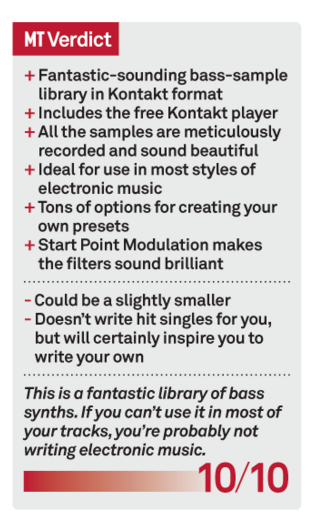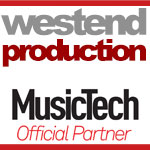Sam Spacey Epica Bass Review
A sample library full of synth basses isn’t something that usually comes to mind when buying your next library. Matthew Mann finds out if Epica Bass is bold enough to take up permanent residence on his hard drive… Details Price £89 / $138 Distributor Time+Space Contact via website Web www.timespace.com System Requirements Kontakt 5 or Kontakt […]

A sample library full of synth basses isn’t something that usually comes to mind when buying your next library. Matthew Mann finds out if Epica Bass is bold enough to take up permanent residence on his hard drive…


Details
Price £89 / $138
Distributor Time+Space
Contact via website
Web www.timespace.com
System Requirements Kontakt 5 or Kontakt Player (included)
![]()
I like sample libraries, but typically don’t use bass-sample libraries. Why? Because I find it easier these days to create my own bass sounds with hardware or software synthesisers. But what if you don’t really have any virtual or hardware synths that do bass well, or you’re not a synth programmer? Well, mega-producer Sam Spacey, the creator of the excellent (and critically acclaimed) Epica virtual synth from Zero-G, has gone to great lengths to create the ultimate bass-synth library for you.
Enter the Bass
Epica Bass is a Kontakt library of nothing but bass. Actually, it’s nothing but synth bass. It works with both Kontakt and the free Kontakt Player (which is even included). It consists of a whopping 26,657 24-bit mono samples and comes in at around 7GB.
All of the samples have been meticulously edited, hand-looped, optimised and organised into a 437-preset library of searing, wobbling, dance-floor pumping, brain-throbbing, gut-twisting arsenal of all-round killer bass instruments.
The samples were all taken from an impressive list of analogue synths, including an original ARP Odyssey Mk III, a Sequential Pro-One, Yamaha CS-15 and CS30 synths, an Oakley Sound Systems Modular, an Analogue Solutions Telemark-K, Oberheim SEM and Matrix 6R synths.
Sam processed all synths through a variety of outboard gear (including a Neve Pre and a UBK Fatso) to get the best sounds before final sampling. It was apparent from listening through the presets that he was very serious indeed, because the sounds are fantastic.

The sounds are laid out in five folders:
• Monophonic
• Arpeggio
• Multi
• Polyphonic
• Raw
The Monophonic folder is by far the largest and contains the bulk of the presets. The amount of programming involved is truly mind-numbing. The Arpeggio folder has patches that are well thought-out and useful. I found presets in this folder lent themselves not only to bass arps, but also to higher register arpeggios that fill out a track nicely.
The Multi folder is full of presets that combine multiple instruments into some excellent layered presets. This is a nice change from the mono folders previously mentioned. You can even play polyphonic patches in the Polyphonic folder.
Finally, the Raw folder is chock-full of unadulterated samples of the original instruments. This a great place to jump in and develop your own twisted sounds. And did I say this is all bass? Hardly: many of these presets can be equally useful as leads and more.
Sampled Filters?
Sam even went so far as to sample the filters of each synth at different stages. This means some patches will move the sample start time so that you are, in essence, moving through the filters of the original instrument.
I can tell you that this technique was used to great effect on these instruments. Also, the instruments were multi-sampled through every single note rather than just a few. So, there’s no aliasing of stretched notes.
And there are at least six ‘Round Robins’ for each note, so the instruments sound as they should…slightly different each time you hit a key. This adds to the character of analogue synths – especially all those lovely vintage ones.
Sam also went into meticulous detail when programming modulation. The mod wheel itself is routed to a number of places – from FX adjustments to sample-start times.
Less is More
There are only three main pages in Epica Bass. Each page is dedicated to one or more tasks and, while options abound, the overall interface remains clean. The main pages are Main, Arp and FX. The Main page has four sub-controls: Amp, Mod, Filter and LFO. Each allows you to tailor the sound to your liking.
The Arp page is dedicated to an onboard (and well-featured) Arpeggiator as well as an Auto-scale function, which makes it easier to compose in different scales if you’re not a music-theory devotee.
The FX page is packed with Native Instruments’ own effects, including: bit crusher, flanger, and chorus to name a few. These effects work well to polish the final sounds to perfection.

Give My Creation Life!
The FX page is one of the simplest to work with. All effects are shown on the FX page, and you only have to turn on the power switch for the effect you want to use and it’s ready to go. The effects include a lo-fi bitcrusher, flanger, chorus, 1176-style compressor, SSL-style EQ section, a convolution reverb, and a basic delay.
All the effects onboard are very good and do wonders for some of the less-animated patches. Oh, and all effects parameters are easy to tweak, with no hidden menus. The dials for each parameter are clearly labelled as to what they do… and a visual indicator at the top of the FX window indicates the exact parameter you’re tweaking, and by how much.
Epica Bass’s FX section is ample and well-featured, having been borrowed from Native Instruments’ own line of effects. They sound good, too. The delay is very simple, but does its job well.
One More Thing…
I have to mention a feature that really impressed me about Epica Bass. The Start Point Modulation mentioned earlier is brilliant. Changing the
sample start time allows the user to hone in on the filter sound of the instrument. This does wonders on things like Depeche Mode-esque filtered basses and resonant leads.
It really reminded me of the way Ensoniq managed the wave samples in the SQ series years ago. I really feel that this method of programming (which can be assigned to the mod wheel or other sources, such as velocity) gives a much better quality to the sounds, rather than relying on emulated filters (although some of those are included, too). The thick, warm sound of the analogue filters is genuine.
Alternatives
Other bass-specific instruments include Spectrasonic’s insane Trilian Bass, which comes in at a hefty 40GB. It covers electric basses as well as a host of synth basses, but also costs about twice the price. Vir2’s Basis is a Kontakt library that features lots of electric and synth basses. It comes in at about 7GB, but doesn’t have the level of programming that Epica Bass does… although it’s also only $99.95.
And, of course, Native Instruments has several bass libraries, but they are all purchased separately unless you have the dough to drop for Komplete. If you can swing the £89/$138 for Sam Spacey’s Epica Bass, I’d suggest that you do, now, before he realises what he’s done and doubles the price.
Conclusion
Epica Bass never left me wanting. I’m very impressed with the layout, the quality of the samples, and the well thought-out programming of the presets. I have found use from so many of the presets already that I can imagine using it somewhere on every track.
Honestly, I’m finding it hard to find fault in this library at all.
If anything, I maybe wish the size of the library was a little smaller, but anyone with a sizable samples drive will never even bat an eyelid.
Of course, while this library may not appeal to everyone, I’m pretty much convinced that most electronic-music producers will get quite a bit of use out of this excellent selection.
The tweakability and programming options onboard allow you to create anything you want and the presets are so good, you’ll find it difficult not to use them just the way they are.

Key Features
● 100-per-cent analogue synth sound sources
● 437 instruments
● Samples from ARP Odyssey, Sequential Pro-One, Oberheim SEM and more
● Recorded with boutique hardware
● FX rack, arp, modulation and more


